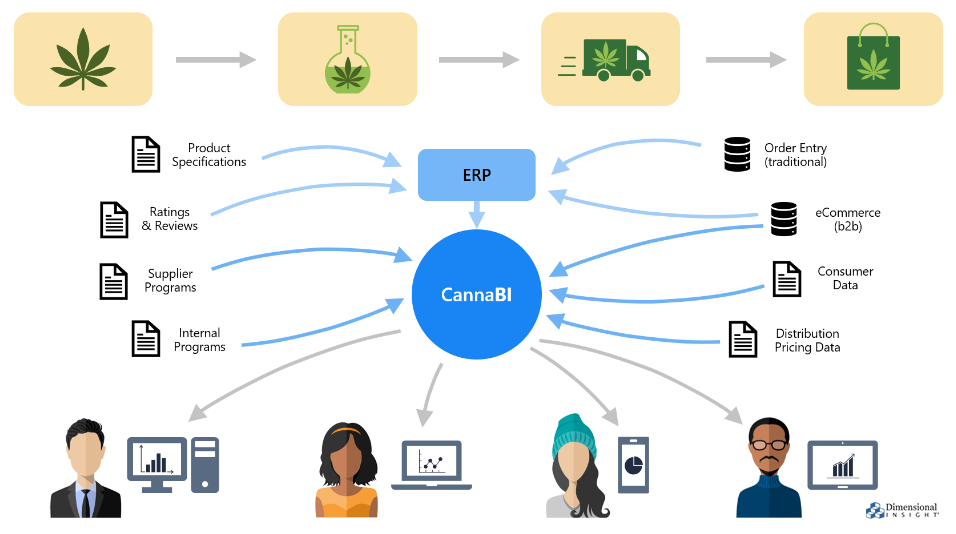Despite only recently witnessing mainstream acceptance, the cannabis market has seen unprecedented growth—and alongside it, the emergence of a surplus of new industry-specific tools and software. However, despite the abundance of newly available digital platforms, many businesses are still struggling to navigate their cannatech software stack and implement solutions that properly address their specific needs and long-term strategies.
As with any modern industry, an optimized and coordinated technology stack is key for any cannabis cultivator, distributor, or retailer looking to realize their business’s potential. And at the epicenter of that stack is a fully integrated and comprehensive analytics platform capable of providing powerful data governance and detailed analysis.
Identifying software gaps and redundancy
With cannabis businesses growing at an unprecedented rate, decision-makers are looking more and more for options that retain their power of choice and allow them to tailor solutions to their own specific needs and goals—in other words, nobody wants to be constrained to a limited and inflexible closed ecosystem.
But that presents a new challenge: how exactly then do businesses determine what platforms they do and don’t need? Enter enterprise analytics.
A powerful and fully integrated analytics platform ingests information from multiple sources into one consistent and reliable access point. With just one interface, businesses can easily view all available data feeds and evaluate gaps and redundancies in the software stack. With so many vendors now offering multiple services in one package, it’s easy for tools to overlap—this in turn means unnecessary expenses and reduced ROI.
Likewise, a gap in the software stack indicates that a business isn’t fully harnessing the potential of its data or capitalizing on available resources. Every level of a company’s operation presents a wide variety of opportunities to cut costs and increase revenue through the utilization of relevant software tools—but these opportunities can only be made apparent when you have a smart BI platform in place to identify them.

Beware analytics vendors who aren’t developers
With so many tech platforms available to choose from, cannabis business owners have to keep one important fact in mind: not all analytics vendors are built the same.
Nowadays, most vendors offer some form of embedded analytics within their applications as a courtesy to their clients. However, most of these embedded features are highly limited in scope and don’t provide a view of the big picture.
Generally speaking, the analytic and governance capabilities of cannabis software tools are built specifically around their own technical infrastructure. This means that although they may be useful in addressing their own reporting needs, they often have severely constricted uses when it comes to other important functions and data channels.
The extensive variety of reporting demands within the cannabis industry means businesses need a platform that can address their needs across the entire organization. Platform-specific analytics simply lacks the infrastructure and support necessary to facilitate enterprise-wide operations. To truly capitalize on their entire tech stack, businesses have to implement a dedicated analytics solution capable of communicating and integrating data across multiple roles and functions.
Data feeds you should be measuring
Although only a few years old, the cannabis industry’s extraordinary growth has presented businesses with a wide variety of software tools to choose from. These include:

That’s a lot of tools, a lot of spending, and a lot of data. With all these tools and systems in place, businesses have to devote a significant portion of both time and money towards administrative functions necessary for keeping their data flowing. As previously mentioned, many of these systems unfortunately do not share the same data collection and export formats, leading to poor interoperability across the enterprise’s many roles and functions.
Building a bridge between feeds
So the question is, with all these disconnected channels feeding us information from different tech infrastructures, how do we coordinate our data in a way that contributes towards enterprise-wide operations?
One of the primary advantages of any comprehensive analytics platform is its integration capabilities, allowing businesses to bring their data from multiple systems together into a single, unified view. This ensures that staff across different departments have access to the same library of consistent and real-time information, regardless of which tools they actually use within their individual roles.
Additionally, this means that businesses aren’t limited to a specific ecosystem. With the right analytics platform at the core of their operations, cannabis businesses are able to hand-pick the right tools for their unique needs. For instance, salespeople can use data collected from inventory management systems to update their respective ecommerce platforms, and then follow-up with another program dedicated entirely to customer loyalty.
Learn more
With so many different technologies now available, cannabis businesses need an analytics platform that can help them organize their incoming data and identify potential gaps and weaknesses. To learn more about how data analytics can help optimize your cannatech ecosystem, check out our full white paper—”Cannabis Technology Landscape—Bridging the Gap with Analytics.”
- How Spirits Brands Can Improve Brand Loyalty with Data Analytics - January 30, 2024
- The Collapse of Herbl, and How Other Cannabis Distributors Can Avoid the Same Fate - January 24, 2024
- Top 5 Blog Posts of 2023 - December 28, 2023




